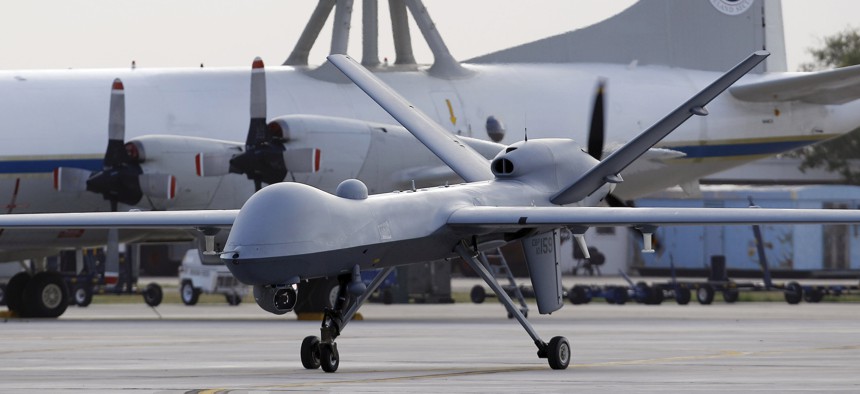
A Predator B unmanned aircraft taxis at the Naval Air Station, Tuesday, Nov. 8, 2011, in Corpus Christi, Texas. AP Photo/Eric Gay
The Endless Aerial Surveillance of the Border
New reports suggest that drone activity at the southern border is spreading to nearby cities, erasing the line between police procedures and immigration enforcement.
Where, exactly, does the border end?
A collaboration between journalism students and the Electronic Frontier Foundation, a civil-liberties group, probes this deceptively simple question. Ask a mapmaker, a geographer, or an average American, and the United States’s southern land border is a thin line extending from Texas to California. But ask law enforcement, and the answer is much more complicated. The same surveillance technologies that Customs and Border Protection and Immigration and Customs Enforcement use to secure the border are also used by local police miles away. The result is a vast dragnet, the surface area of which keeps growing as the special authority granted to agents in certain areas of the border quietly expands.
Using online and archival searches, public-information requests, and state and local freedom-of-information laws, students at the University of Nevada’s Reynolds School of Journalism and their professor, Gi Woong Yun, partnered with Dave Maass, a principal investigator at EFF, to create an “Atlas of Surveillance”: a map of advanced technology used by police departments along the border.
The variety of devices being used near the border is astounding. In southwestern communities near the U.S.-Mexico border, the team recorded nearly 230 instances of local police deploying advanced technology: facial-recognition software, cellphone-tracking “sting ray” towers, real-time crime centers, license-plate cameras, gunshot-detecting acoustic-surveillance devices, drones, and spy planes. These devices reveal where people travel, as well as whom they call, text, and visit. The tools can also identify people without their knowledge or consent.
Related: Military-Style Surveillance Technology Is Being Tested in American Cities
Related: DEA and ICE are Hiding Surveillance Cameras in Streetlights
Related: As Exports of Surveillance Tech Rise, Freer Countries Face a Choice
Drones are especially useful to law enforcement and immigration authorities because they’re versatile, undetectable, and relatively inexpensive, and they can link together data from multiple sources. “Companies that are developing these surveillance technologies, they are quite creative in terms of mixing and matching the technologies,” Yun says, noting, for example, that some drones are equipped with license-plate readers (LPRs), which use cameras to track vehicles on city streets. An LPR-equipped drone could theoretically identify and track a single car for miles.
Mixing and matching technology in this way provides law enforcement with certain loopholes. Police need a warrant before placing a GPS tracking device on your car, for example, but not for querying an LPR database for a list of all your locations. Technology develops faster than privacy laws can keep up, especially in border communities, where law enforcement already enjoys enhanced privileges. Within 25 miles of the border, CBP agents theoretically operate under qualified immunity, empowering them to patrol private lands. Within 100 miles of the border, CBP agents can set up checkpoints and question, search, and potentially detain travelers if they believe they have probable cause.
“You can view this extension of the border as a [way] for federal authorities to maintain jurisdiction over large swaths of land,” says Mana Azarmi, a policy counsel at the Center for Democracy and Technology, “[and] permit them to do more and more invasive things.”
While CBP’s drone surveillance is restricted to the 100-mile border zone, the agency records footage and collects data—largely unnoticed and unchallenged—far beyond that. The EFF report found that many local and state police departments use drones as part of a suite of advanced tech, meaning that for citizens living in border communities, aerial surveillance is ongoing at the federal, state, and local levels simultaneously. Azarmi worries that this allows local police to overstep the boundaries of justifiable surveillance, “turning border enforcement into more of a dragnet surveillance system.”
Included in the EFF’s data set is a series of CBP missions conducted using the Predator B drone, which is equipped with long-range cameras and sensors to detect illegal border crossings and coordinate with CBP agents on the ground. The report also includes a link to a data set that catalogs hundreds of drone flights over Texas hospitals, community centers, churches, and so on, from 2015 to 2017; the state’s Department of Public Safety was looking for marijuana fields and tunnels. Though U.S. agencies don’t have the authority to surveil Mexico, the Texas report notes that drone flight paths dipped into Mexico regularly.
Not only do drones make borders immaterial, but federal officials have also obfuscated the very location of the border. In February of last year, Ricardo Palacios, a 74-year-old rancher in Encinal, Texas, sued CBP for trespassing. His ranch is about 35 miles outside the nearest border crossing, so one would reasonably assume he’s safe in saying he’s firmly on American soil. But when Palacios found and removed a surveillance camera placed on his property by border-patrol agents, he was threatened with lawsuits and criminal charges. CBP, he argued in the suit, has jurisdiction only within 25 miles of the border, not 35.
The special privileges granted to immigration authorities like CBP are becoming untethered from the geographic border, eroding the rights of people on the ground and, of course, those visible from the air. This is a “border crossing” of its own, a transgression of the constitutionally established boundaries of privacy. These special exceptions encompass enormous swaths of land. If law enforcement can spy on people beyond—and above—its established limits, where exactly does its surveillance jurisdiction end?



